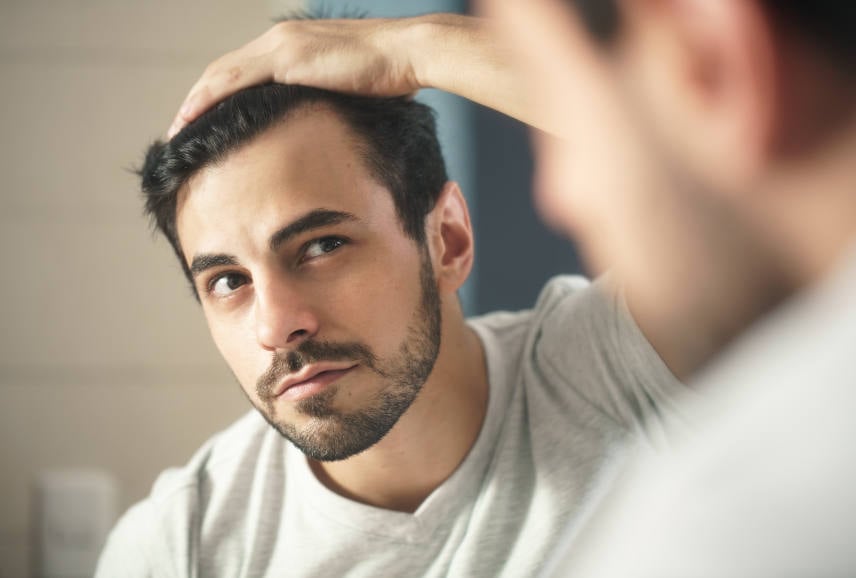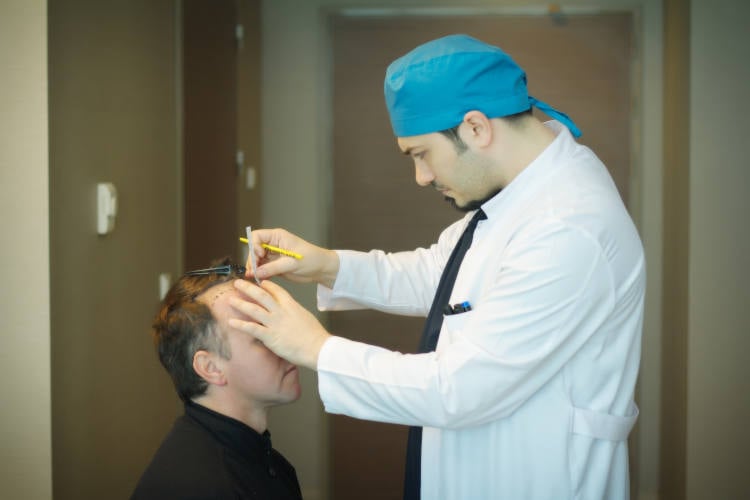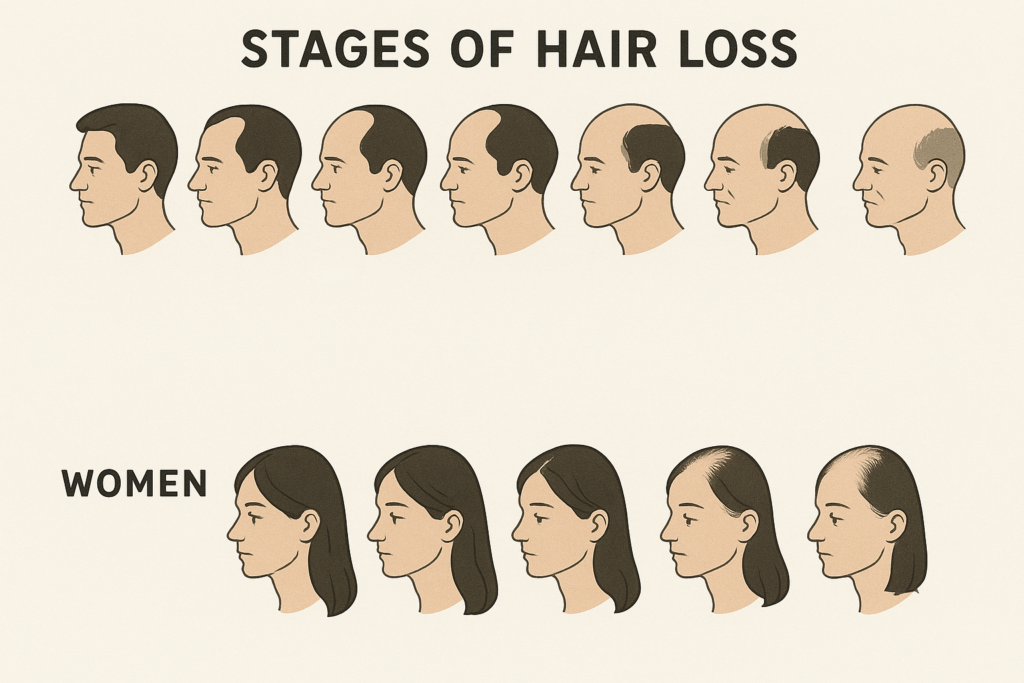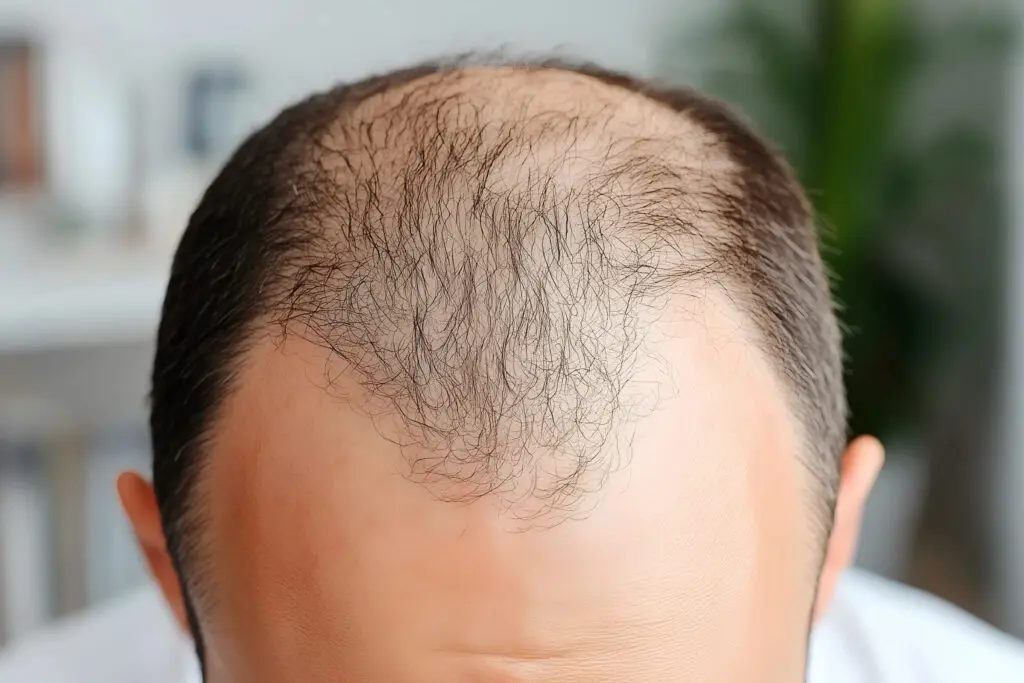
Can I Make A Receding Hairline Grow Back?
A receding hairline is often the first visible sign of hair loss in men and women, and is understandably distressing for those affected. In this article, we’ll be explaining the common causes of a receding hairline, examining the available treatments, and outlining when is the right time to pursue a hair transplant.
Understanding Receding Hairlines

A receding hairline, a common form of male pattern baldness, involves the gradual loss of hair along the edges of the scalp, typically starting above the temples. This progressive recession creates a V-shaped pattern, advancing over time. It results from genetic predisposition and hormonal factors, particularly the conversion of testosterone into dihydrotestosterone (DHT), which shrinks hair follicles. While primarily affecting men, women can also experience receding hairlines due to hormonal changes, ageing, or underlying health conditions.
Receding Hairlines in Men and Women
There are two major players when it comes to receding hairlines. Male pattern baldness and female pattern baldness. These are then further characterised into stages. There are a number of ways in which the stages of a receding hairline are tracked. One of the most common scales used is the Hamilton-Norwood scale, which is a simplified overview of the progression of male pattern baldness.
Male pattern baldness
Male pattern baldness, or androgenetic alopecia, is a common form of hair loss characterised by a gradual thinning of hair, typically starting at the temples and crown of the head. It results from a combination of genetic predisposition and hormonal factors, particularly the influence of dihydrotestosterone (DHT) on hair follicles.
Female pattern baldness
Female pattern baldness, or androgenetic alopecia in women, is a prevalent type of hair loss characterised by a diffuse thinning of hair across the scalp. It often starts with widening of the parting and can progress to more noticeable hair loss. Genetic and hormonal factors, including the influence of androgens, contribute to this condition.
Common Causes of a Receding Hairline

A receding hairline can be attributed to various factors:
Genetics
Genetics can play a huge role in the appearance of a receding hairline. A common cause of hair loss in both men and women is androgenetic alopecia, more commonly known as male pattern and female pattern baldness.
While this form of hair loss in women typically presents as steady thinning across the hair parting and crown, in men it is more common to see it present as a receding hairline that gradually forms an M shape across the temples.
If you have a family history of receding hairlines and pattern baldness, your likelihood of suffering the same is much higher. Typically, you will notice the loss occurring at the same age as your family members did.
Hormones
Another factor to consider is hormonal changes. The scalp is affected in different ways by hormones like dihydrotestosterone (DHT). You may have come across this in your research, as it is the main hormone that contributes to hair loss. This is due to it causing the hair follicles to become smaller.
Stress
A hidden attacker to your hairline, which is often ignored among harsher-sounding symptoms is stress. It is actually a big trigger for hormonal fluctuations, with studies suggesting that individuals experiencing stressful events were more likely to have thinning hair than those who had not.
Diet
While diet alone may not directly cause a receding hairline, poor nutrition can contribute to overall hair health and potentially exacerbate existing hair loss. A diet lacking in nutrients such as protein, B vitamins (particularly biotin) and iron may lead to weaker hair follicles, increased hair shedding, and potentially worsen conditions like male or female pattern baldness, which can manifest as a receding hairline over time.
Ageing
As individuals age, various changes occur in the body, including those affecting hair follicles. With age, hair follicles may become less active and produce thinner, shorter hairs. Additionally, hormonal changes associated with ageing, such as decreased levels of testosterone and changes in hormone sensitivity, can influence hair growth patterns and contribute to a receding hairline.
Can a Receding Hairline Grow Back Naturally?

Natural regrowth of a receding hairline depends on the underlying cause of the hair loss. In cases of stress or poor nutrition, it is possible that by addressing these issues you might see a return of healthy hair growth. However, in the case of androgenetic alopecia, this is a form of genetic hair loss that cannot be reversed without medical intervention.
If you do find that your condition requires medical attention, do not be daunted. This is a very common and treatable issue. A receding hairline, commonly associated with male pattern baldness, affects approximately 30-40% of men by age 35 and 50% by age 50. However, it’s also prevalent in women, with around 40% experiencing hair loss by age 50.
Caucasians tend to have a higher prevalence of male pattern baldness compared to individuals of African or Asian descent. Studies have shown that individuals of European descent are more likely to experience hair loss, particularly at a younger age, compared to individuals of African or Asian descent.
Diagnosis of a Receding Hairline
It is not only significant to understand if you have a receding hairline, but also what kind of hair loss is causing this to treat it effectively. The diagnosis of a receding hairline typically involves the following steps:
- Visual examination: A healthcare professional visually assesses the patient’s hairline, noting any signs of recession or thinning.
- Medical history: Information gathered about the patient’s family history of hair loss, past medical conditions, medications, and lifestyle factors.
- Scalp examination: A closer examination of the scalp to evaluate hair density, follicle health, and any signs of inflammation or scarring.
- Diagnostic tests: In some cases, additional tests such as a pull test, hair biopsy, or blood tests may be conducted to determine the underlying cause of hair loss.
- Differential diagnosis: Differentiating between various types of hair loss patterns to accurately diagnose a receding hairline and develop an appropriate treatment plan.
Medical Treatments for Hair Regrowth
Treating a receding hairline is possible, and there are various options out there that offer results. These include medications, surgery, and some natural methods as well. We outline the options here, and their perceived effectiveness so that you can choose what is best for you.
Non-surgical treatments
- Minoxidil: Minoxidil is a topical treatment It works by stimulating hair follicles and increasing blood flow to the scalp. Results show in 3-6 months, but the treatment must be continued regularly to maintain results. Minoxidil is not a cure, but it can help to slow the progression of hair loss and improve the appearance of the scalp.
- Finasteride: Finasteride is an oral medication that works by blocking the production of DHT, a hormone that can contribute to hair loss. Results are seen in 3 months, but these medications can have side effects, including decreased libido, erectile dysfunction, and ejaculation disorder. It is also not recommended for women who are pregnant or planning to become pregnant.
- PRP: PRP (Platelet-Rich Plasma) therapy for receding hairlines involves injecting concentrated platelets from the patient’s blood into the scalp to stimulate hair growth. It’s a minimally invasive procedure with promising results, often used in conjunction with other treatments for optimal outcomes.
Lifestyle Changes to Prevent Further Hair Loss
As you discuss any medical treatments with your GP, there are a number of lifestyle changes you can make in the meantime to better protect your hair and slow the progress of your receding hairline:
- Gentle shampoo: Gentle shampoos can help with receding hairline by maintaining scalp health. Harsh chemicals in regular shampoos can irritate the scalp, leading to inflammation and potential damage to hair follicles. Gentle formulas cleanse without stripping natural oils, promoting a healthy scalp environment conducive to hair growth, and potentially slowing down hair loss.
- Low-level light therapy: Low-level light therapy (LLLT) is a non-invasive treatment for receding hairlines. It uses red or near-infrared light to stimulate hair follicles, promoting growth and slowing down hair loss. While results vary, LLLT is generally well-tolerated and can be used in combination with other therapies for addressing receding hairlines.
- Diet: Diet plays a vital role in your follicle health needs. Look for foods that are high in antioxidants, which can help your hair appear thicker and are good supplemental receding hairline treatments. Foods such as blueberries and spinach contain ingredients that help counteract oxidative stress and keep your hair from ageing as quickly.
- Scalp massage: Scalp massages for receding hairlines can improve blood circulation to the hair follicles, delivering essential nutrients and oxygen for healthier hair growth. Additionally, massages reduce stress levels, which can contribute to hair loss. While not a standalone solution, regular scalp massages can complement other treatments in managing receding hairlines.
- Lower DHT levels: Lowering DHT (dihydrotestosterone) levels can help with receding hairlines by reducing the hormone’s damaging effects on hair follicles. DHT is linked to the miniaturisation of follicles, leading to hair thinning and eventual loss. Medications like finasteride block DHT production, slowing down hair loss and potentially promoting regrowth in individuals with receding hairlines.
When to Contact a Specialist?
Should you find that your receding hairline is progressing rapidly and/or that your hair loss is not slowing despite continued use of medications and commitment to lifestyle changes, it may be time to contact a specialist about further treatment options.
Hair transplant surgery
While regrowth of hair with minoxidil and other medicinal and natural remedies can prolong hair loss to some extent, the only proven long-lasting treatment is a hair transplant. Unlike temporary fixes such as topical treatments or wigs, hair transplants provide a genuine and long-term solution. The advanced techniques employed in these procedures, such as follicular unit transplantation (FUT) or follicular unit extraction (FUE), offer minimal scarring and a seamless, natural appearance.
To learn more about the procedure, recovery, and what results to expect, read our step by step guide to hair transplants in Turkey. This surgical procedure involves transplanting healthy hair follicles from donor areas to the balding regions, ensuring natural-looking and permanent results.
FAQ
How effective are lifestyle changes in preventing a receding hairline?
Lifestyle changes such as a balanced diet, regular exercise, stress management, and avoiding smoking can help improve overall hair health and potentially slow the progression of a receding hairline.
Are there any non-surgical treatments that can help regrow a receding hairline?
Yes, non-surgical treatments like Minoxidil and PRP therapy can stimulate hair growth and help regrow a receding hairline to some extent.
How long does it take to see results from non-surgical treatments?
Results from treatments like Minoxidil and Finasteride can take 3 to 6 months to become noticeable. Consistency is key, and continued use is necessary to maintain results. A hair surgery is currently the only permanent solution against hair loss.
What are the long-term success rates of hair transplant surgeries for a receding hairline?
Hair transplant surgeries, such as combining the FUE method for graft extraction and the DHI technique for their insertion, have high success rates. Note that our patients experience significant improvement and lasting results when following post-operative care instructions.
Can stress alone cause a receding hairline, and how can it be managed?
While stress alone may not cause a receding hairline, it can exacerbate hair loss. Managing stress through techniques like meditation, yoga, and adequate sleep can help mitigate its effects on hair health.


